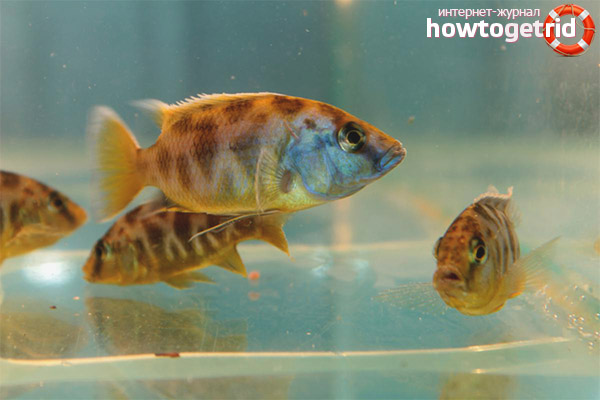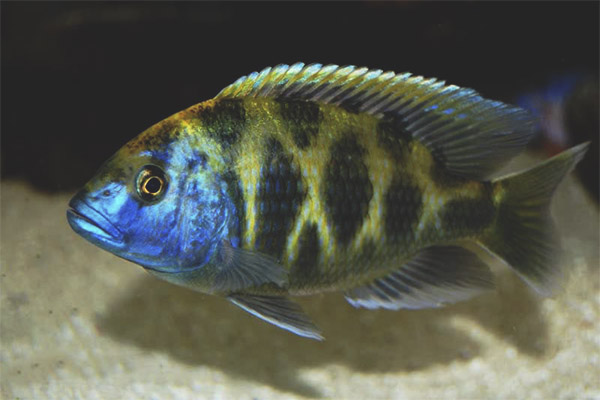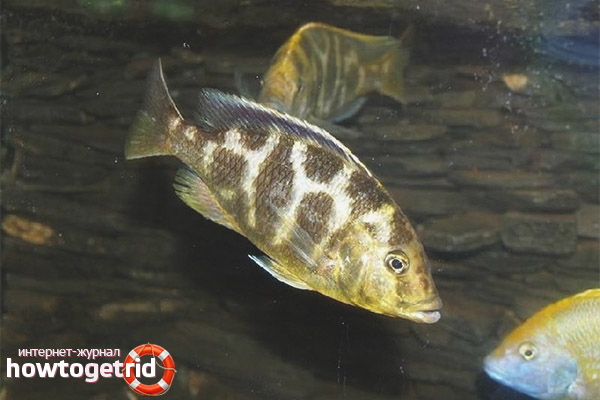The content of the article
Golden leopard or haplochromis venustus is one of the most common species of aquarium cichlids. Their place of origin is the African Lake Malawi.
Male individuals have an unusually bright color. On their golden-yellow background are chaotic specks of dark olive color, which disappear as they grow older. They have a bright blue head and yellow fins from the side of the tail, and the tail is grayish-green. All other fins are blue. The larger representatives, whose size is more than 10 centimeters, have dark stripes that go from the mouth to the dorsal fins; they are more pronounced in the females. Females and young animals are rather faded and gray in comparison with males. The body of females is characterized by a light beige color with large brown spots scattered on it.
Description
These are small-sized fishes that belong to cichlid species, have interesting appearance and have memorable colors, which are their main distinguishing feature.
The fish has a flat body and high back. It is slightly yellowish in color, with a greater or lesser degree of pigment intensity. Large dark green spots are their hallmark. It is thanks to them that the golden leopards got their name. Another breed trait are dark stripes that are raised up at the corners of the mouth and continue in the eye area. Males have clearer stripes than female fish.
Male fishes are distinguished by the mouth of blue shades. The fins on the back of them are dark in color and convex in shape, have a golden rim. Fins on the tail, most often gray or gray-green, have a bright yellow-orange border. The colors of male leopards at puberty are radically different. The areas of the head and neck become blue, and the spots on the body become not so bright or disappear altogether.
Golden stripes in the forehead extend to the dorsal fin. The size of mature leopards in the natural environment can range from 22 centimeters. Under the conditions of an aquarium, the body of representatives of this breed of fish rarely reaches 15 centimeters.
How do they live in natural conditions?
The only place on the planet where golden leopards live under natural conditions is African Lake Malawi. They live in coastal areas and never swim to a depth of more than 12 meters. They are found in sandy areas and on rocky shores. Despite their small size, they are predators.
Golden leopards have a very original way of hunting. They are waiting for their prey on the ledges of the rocks, pretending to be lifeless. If there is a naive fish nearby, they attack it swiftly. Such a hunt is called an “ambush.”
These fish live in small schools of several individuals. The male is always the head of the family, the rest of the pack are females who are members of family relationships.
Content Features
The difficulty of keeping gold leopards is qualified by specialists at an average level. They are not too capricious in food, but they require conditions that are as close as possible to natural ones.
Aquarium
Taking into account the size of these fish and the fact that they live in flocks, it is necessary to understand that a small size aquarium will not work.It is desirable that it be more than 200 liters. Experienced aquarists tend to keep the species of fish of this breed in order to reduce the risk of aggressive actions of cichlids in relation to other inhabitants in the aquarium, especially during spawning.
Landscape design
In the aquarium there must be shelters so that, if necessary, the fish can hide in them. Their functions can perform slides, grottoes, caves. They must be installed in an amount not less than the fish in the aquarium. Such an approach will minimize the risk of conflict between its inhabitants.
Bottom arrangement
The bottom is best to cover with coarse sand, mainly river or fine gravel. In the case of using gravel, it is necessary that it be run in, as the fish of this breed enjoy digging in it. In addition, for this reason it is necessary to securely secure aquarium decorations.
From vegetation, preference should be given to algae, which have a strong root system and large species.
Water parameters
An important condition is to maintain a suitable temperature at around 26 degrees.The neutral level of PH is about 8 units. It is also important to adhere to an acceptable level of alkali - from 8 to 20.
In order to maintain optimum conditions, it is necessary to use quality filters and siphon the ground during. This should be done at least once every 7 days. Every week, replace one third of the water in the aquarium with fresh water. In good and comfortable conditions, golden leopards live long enough, about 8 years.
Nutrition
Golden leopards are predators. Therefore, for their food should give preference to frozen and live feed. They like fish meat, shrimp, earthworms, and also snails and even crab sticks. Often they require a vegetative feeding, which can be algae growing in an aquarium. Periodically, they can be fed with a special food.
They feed these fish several times a week. The remaining food must be removed from the aquarium in order not to pollute the water with food decomposition products. At the same time, food residues emit toxic substances that are very dangerous for fish.
Cohabitation with other fish

Golden leopards are not very suitable for breeding in common aquariums. If there is no other way out than to settle with other fish. New neighbors must necessarily treat cichlids or be large and have a peace-loving disposition, otherwise there is a risk that a new inhabitant of the aquarium may suffer.
Breeding characteristics
To speed up spawning, you should increase the temperature in the aquarium by a couple of degrees. Representative males themselves choose places for clutches, and, in general, they prefer flat surfaces that are well cleaned. Eggs move to the female's oral cavity, where they are fertilized and incubated for 14-21 days. During the first week after birth, the babies are under the strict supervision of the females, and if necessary, they again take refuge in her mouth.
After 7-10 days, the fry themselves move inside the aquariums. During this period, it is possible and even advisable to move them away from their parents to a different environment. To feed the fry, you can use live or frozen feeds of Nauplii Artemia or Cyclops.
Video: Golden Leopard Aquarium Fish












To send